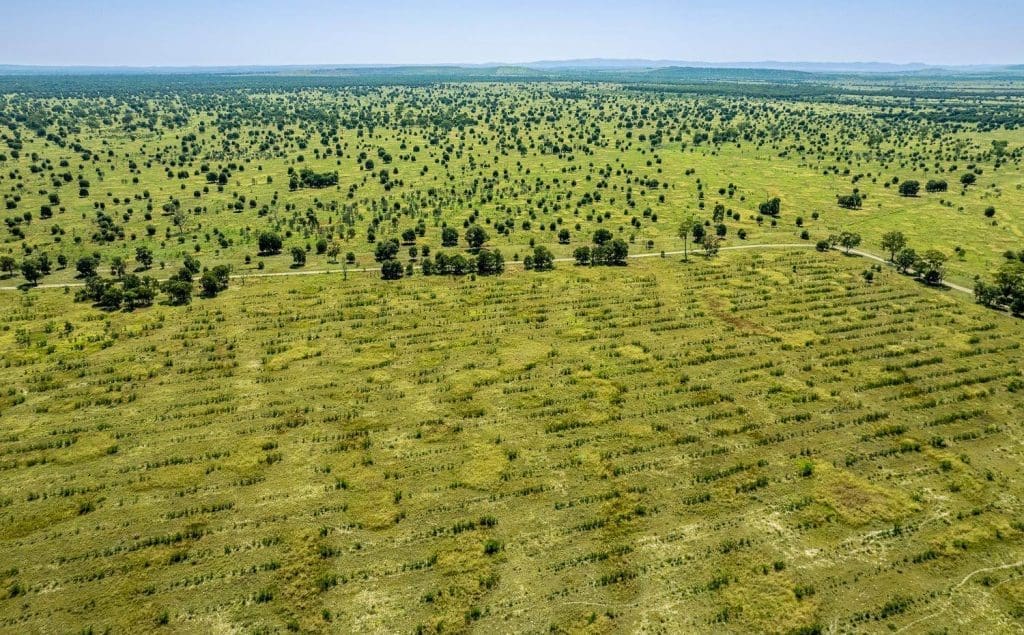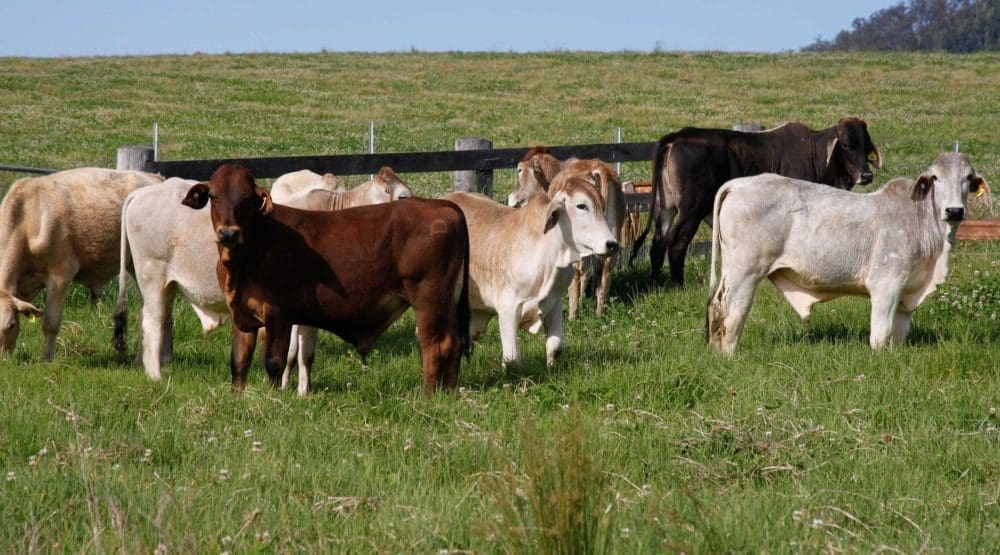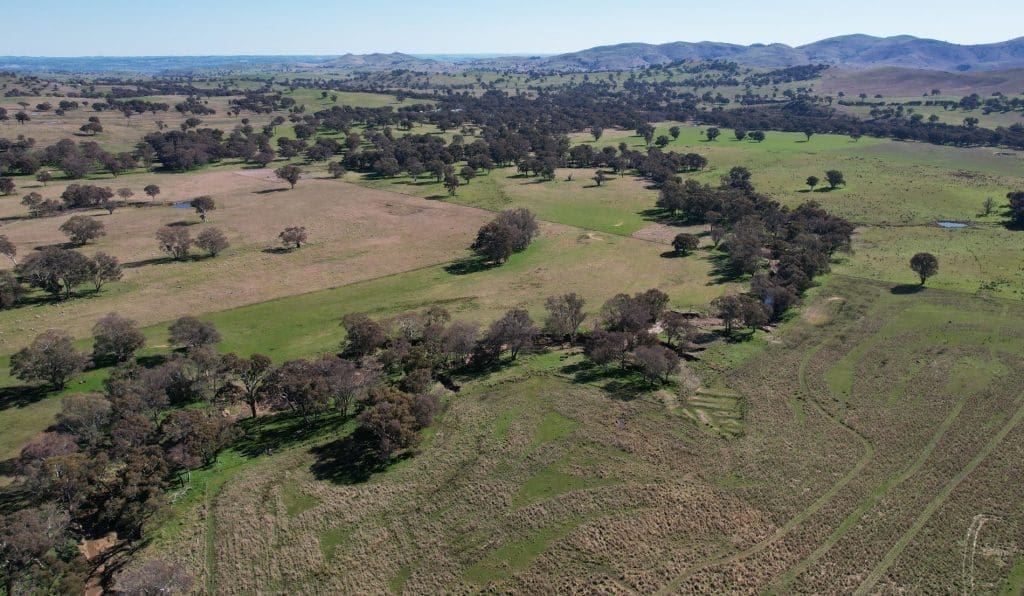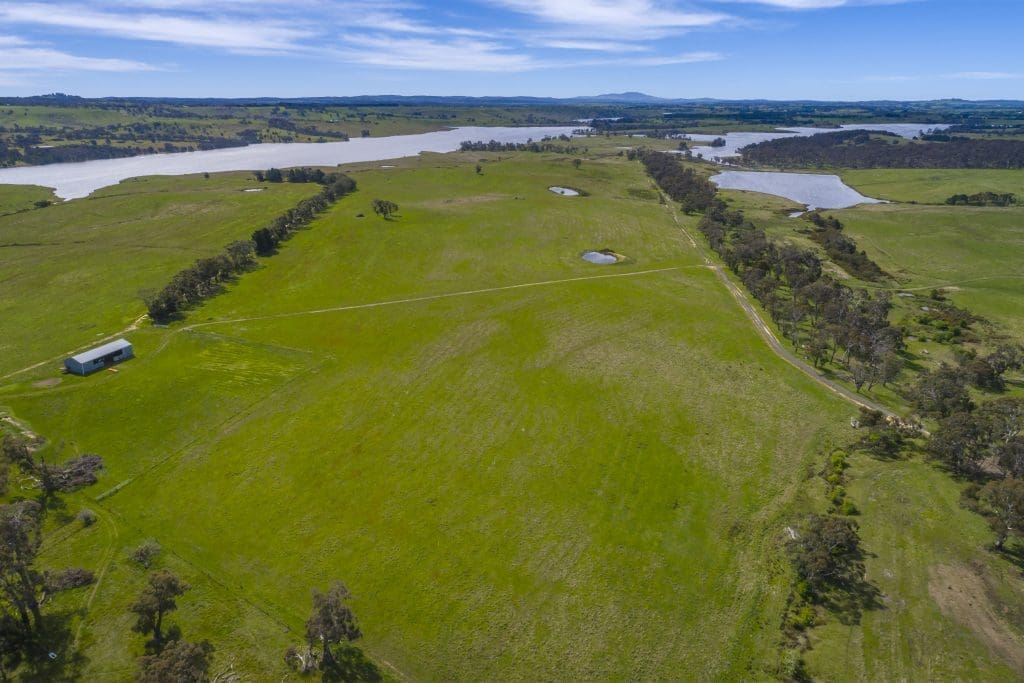
Leucaena development in the foreground, and buffel country beyond, on Rainbow’s End in Central Queensland
THIS week’s property review examines what $10 million will buy as a grazing investment in different regions across Australia.
We’ve limited the parameters to backgrounding/finishing type country, given the wider variation in breeding country in each region. In the various examples below, the Victorian property was by far the most expensive, on an adult equivalent basis.
Central Queensland
Brad Hanson from Hourn & Bishop said in Central Queensland, $10 million can buy 1200ha to 1600ha of high quality developed brigalow scrub country returning 0.8kg of average daily weight gain.
“That country is high carrying capacity generating high returns. It is well located close to marketing centres and feedlots,” he said.
“The country is suited to backgrounding or fattening and running between 800 and 1000 head of cattle.”
Mr Hanson said a property in this price bracket has been improved to a point where the waters are handy, the pastures are well improved and in good condition and the infrastructure is reasonable.
A prime example is this recent listing.
Rainbows End (pictured above) spans 1241ha and is situated 11km from Moura in the heart of the Dawson Valley.
The property has prolific, heavy carrying, melonhole country with improved buffel pastures suitable for backgrounding, breeding or finishing stock.
Centrally located to a number of livestock selling complexes and abattoirs, Rainbows End can carry 990 adult equivalents, but has been stocked with 450 cows and calves (with calves removed as weaners).
The country consists of brigalow, blackbutt, belah and softwood scrub soil types, with 80ha developed to leucaena.
The natural melon hole country offers abundant seasonal surface water and a 5km gully (which diagonally traverses the property) and that regularly supplies water to four large, interconnected dams piping water to six tanks and 15 troughs.
Just this week, the highly improved, productive beef enterprise El Rocco, in the renowned Rhyddings/Roundstone district of Queensland’s Central Highlands exceeded expectations selling for a record of $14.5m or $7207/ha bare of stock and plant.
Located 44km west of Moura and 109km west of Biloela, the 2012ha weight gain factory is capable of running 1000 backgrounders (up to feedlot entry weight) or one adult equivalent to two hectares, reflecting around $14,500/AE.
The gently undulating brigalow, blackbutt and belah scrub country has productive red and brown scrub soils. With the exception of creek lines and shade camps, all areas have been cleared and well established to improved pastures.
El Rocco is watered by six dams and 21 troughs.
Southern QLD
In October last year, a productive grazing property on southern Queensland’s western downs sold for $10.95m bare.
Held by members of the Rayner family since 1856, the 2688ha Moraby is 45km west of Condamine and 75km south-west of Miles. It neighbours the Teys Condamine feedlot and is close to major selling centres including Dalby and Roma.
Featuring brigalow, belah and wilga country, with a small percentage of lighter loam and timbered country, Moraby has a good mix of improved pastures, buffel, native grasses and herbages in seasons.
Well fenced and subdivided into 10 paddocks, the property has a central laneway system for ease of management connecting to the cattle yards.
The property is well-watered by an artesian bore supplying 11km of poly pipe to 12 troughs, nine dams and seasonal flows in the Moraby and Dogwood Creeks.
Land value only, Moraby sold for $10.6m or $3943/ha. It was running 500 cows and calves or 775 adult equivalents, reflecting between $13,500 and $14,000/AE.
Northern NSW
Col Medway from LAWD estimates most high-rainfall grazing country in New South Wales is trading between $1300 and $1500 DSE.
Currently, eastern fall grazing in northern New South Wales is under offer for $8.8m bare of improvements or $1269/DSE.
The 1196ha Number One, which formed part of the Cooplacurripa Aggregation, is situated between Nowendoc and Wauchope.
It features productive land rising from Rowley River flats through to arable slopes and timbered hills.
Currently running 6300 dry sheep equivalents, selling agent LAWD believes significant production upside is possible by further fertiliser investment, sowing pastures on the arable land and developing irrigation.
Water is secured by multiple sources such as the Rowley River, creeks and 23 dams.
The operation benefits from an average annual rainfall of 1064mm and has an under-utilised 82 megalitre river water entitlement, with underground mainlines connected to around 20ha.
In April last year, a Riverina producer chasing expansion paid $8.92m bare for high rainfall New England grazing country in northern New South Wales.

Queensland bred Brahman cross cattle, used as restockers after the drought, on Number One
The 1461ha Rimbanda, originally settled in 1832, is located at Kentucky South, halfway between Tamworth and Armidale.
The breeding and backgrounding operation was running 600 cows and calves or 9000 dry sheep equivalents. Minus the improvements, the sale price equated to $5592/ha bare or $13,617/cow area.
Situated in an 800-900mm rainfall area, the soils on Rimbanda comprise one third basalt, one third traprock and one third fine granite.
The country ranges from creek flats to open softly undulating, to well sheltered timber hills and mountains. Around 50 percent of the property is pasture improved, with the balance natural pastures. Rimbanda is watered by close to 40 dams and four creeks.
The sale included shedding, cattle yards and good condition fencing.
Southern NSW
In October 2022, 733ha of high rainfall breeding and grazing country on the Southern Tablelands of New South Wales made $8.2 million.
Situated in a 690mm rainfall region, Talbragar is located at Bookham, south of Yass. On a bare basis, excluding improvements, it sold for $1300/DSE.
The operation breeds and trades cattle and runs a self-replacing Merino flock. The estimated carrying capacity is 5900 dry sheep equivalents or 8.1DSE/ha.
The cattle and sheep breeding enterprise is also capable of finishing due to well established improved pastures, comprising phalaris, cocksfoot, ryegrass and native perennial grasses, and dual-purpose cereal crops.
Reliable water is provided by dams, a permanent creek and a solar bore which supplies a header tank and reticulates to a network of troughs.
Fit-for-purpose operational improvements include a four-stand shearing shed with steel sheep yards, cattle yards with a veterinary crush, machinery sheds, an 80t grain silo storage facility and an airstrip.

Talbragar is currently running a self-replacing Merino flock, and breeding and trading cattle. The estimated carrying capacity is 5900 dry sheep equivalents or 8.1DSE/ha.
Victoria
Highly productive grazing country in the renowned Macedon Ranges of Victoria recently sold for $8.45 million or $27,435/ha bare.
The 308ha Tylden Waters is located 7km from Kyneton, 18km from Macedon and 74km north-west of Melbourne in a 790mm average annual rainfall region.
The block has deep friable clay soils and areas of volcanic red basalt soils – ideal for high performance pastures.
The estimated carrying capacity is 3768 dry sheep equivalents (14.1DSE/ha or $2242/DSE), 471 steers (1.8AE/ha) or 200 cows and calves equating to $42,250/cow area.
The property benefits from an all-weather laneway system connecting each paddock, stock-proof fencing and fit-for-purpose operational infrastructure.
Fronting the Upper Coliban Reservoir, Tylden Waters has a large on-farm water storage with a capacity of 650 megalitres.

The highly productive Tylden Waters grazing country in the Macedon Ranges of Victoria recently sold for $8.45 million or $27,435/ha bare.
South Australia
Late last year, three neighbouring grazing properties (Punari, Oakbank and Taratap) in South Australia’s mid-south-east made close to $30 million or $9883/ha bare of livestock. Carving-off the 1196ha Oakbank, we can see what a $10m purchase in the region might look like.
Situated in the tightly-held area of Taratap, 33km north of Kingston, the 1196ha Oakbank is suited to prime lamb and cattle production and capable of running between 14.5DSE/ha and 15DSE/ha or one breeder cow per two hectares.
Situated in a 575mm rainfall region, the property is suited to all year-round grazing.
It has a balance of well-drained, productive black soil types on the flats growing an abundance of pastures during late spring and early summer. This is complimented by the high ground which provides warmth and shelter (allowing livestock to mother up) over the winter months.
The improvements included a three stand shearing shed and cattle yards in good working order.
Western Australia
There have been very few grazing sales in Western Australia over recent years, however, Greg Smith from Elders was able to hypothesise what a $10 million sale would look like in his region.
“In the drier pastoral zone, depending on the region, a $10m pastoral lease (with no carbon income because the market is distorting grazing values) would span between 100,000 and 300,000ha and run around 4000 head of cattle,” he said.
Mr Smith said depending on the quality of the country and the level of improvements, the adult equivalent value would be between $1000/AE to $1500/AE.
“The breeding country would be located somewhere in the Gascoyne or lower Pilbara. There is nothing of that value (ie too low) in the Kimberley and further south and the property sizes are smaller).”

Looks like North Qld didn’t get a run. Now I know how Tasmania usually feels.
It would have been interesting to see how South Australia shaped up, not the South East but the pastoral leases. I think that there would be some very contorted findings there given what prices have been paid in the past few years.